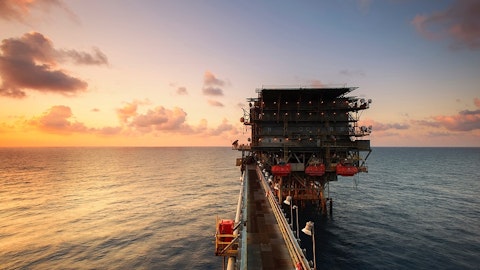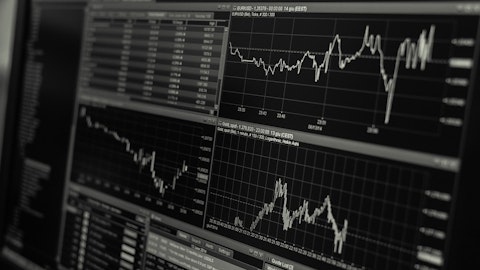Kinder Morgan, Inc. (NYSE:KMI) Q3 2023 Earnings Call Transcript October 18, 2023
Kinder Morgan, Inc. misses on earnings expectations. Reported EPS is $0.25 EPS, expectations were $0.26.
Operator: Good afternoon and thank you for standing by, and welcome to the Quarterly Earnings Conference Call. [Operator Instructions] Today’s conference is being recorded. If you have any objections, you may disconnect at this time. It is now my pleasure to turn the conference over to Mr. Rich Kinder, Executive Chairman of Kinder Morgan. Sir, you may begin.
Rich Kinder: Okay. Thank you, Michelle. And before we begin, I’d like to remind you as usual that KMI’s earnings released today and this call include forward-looking statements within the meaning of the Private Securities Litigation Reform Act of 1995 and the Securities and Exchange Act of 1934, as well as certain non-GAAP financial measures. Before making any investment decisions, we strongly encourage you to read our full disclosures on forward-looking statements and use of non-GAAP financial measures set forth at the end of our earnings release, as well as review our latest filings with the SEC for important material assumptions, expectations and risk factors that may cause actual results to differ materially from those anticipated and described in such forward-looking statements.

Aerial view of an oil and gas pipeline, spanning vast landscapes.
My remarks at the beginning of our second quarter investor call, I talked about future demand for natural gas and why that makes us bullish about the future of KMI. The biggest portion of that growth in demand is attributable to LNG. So let me follow up on this call by reviewing the latest estimates regarding future U.S. feedgas demand to serve the country’s LNG export facilities. S&P Global Commodity Insights estimates LNG feedgas demand at 13.1 Bcf a day for 2023 and projects that it will grow to 24.7 Bcf a day in 2028 and to 27.5 Bcf a day in 2023, IEA estimates that U.S. LNG exports, as a share of global LNG supply will grow from 20% in 2022 to almost 30% in 2026. All of these numbers demonstrate incredible growth, which is driven, of course, by new LNG export facilities could have been FID, most of which are currently under construction.
Now how does this increased demand affect the Midstream Energy segment and specifically Kinder-Morgan? To meet this increased feedgas demand, the country is going to need additional pipelines and not just header pipelines to the export terminals, but also significant expansion in the pipeline and infrastructure upstream from those header systems and terminals. While we believe Haynesville production will grow the supply portion of this demand, because of its proximity to the LNG facilities in Louisiana and Southeast Texas, we will not be able to fulfill all these growth volumes and additional takeaway capacity from multiple basins will be required. Access to basins is also important to help solve the excess nitrogen problem confirming LNG export facilities.
While there are other midstream players will also benefit, we think Kinder Morgan, which is currently transporting a little less than half of all U.S. LNG feedgas is in an excellent position to take advantage of this tremendous opportunity because of the extensive footprint of our pipeline network, particularly in Texas and Louisiana where so much of the additional demand will occur. And with that, I’ll turn it over to Kim and the team.
See also 12 Best Clean Laundry Detergent Brands and 12 Best Places to Retire in Honduras.
Q&A Session
Follow Kinder Morgan Inc. (NYSE:KMI)
Follow Kinder Morgan Inc. (NYSE:KMI)
Kim Dang: Okay. Thanks, Rich. I’ll make a few overall points, and then I’m going to turn it over to Tom and David to give you more details. We had a solid quarter financially. We continue to find opportunities to add to our backlog. We repurchased $73 million in shares at an average price of $16.77. That brings us to $472 million of share repurchases year-to-date at a very attractive price of $16.58. Financially, our portfolio of assets performed well with contributions from the segments up 5%, driven by increases in natural gas, products and terminals. Products had a particularly strong quarter, up 22%. Overall, our results were largely flat because of increased interest expense and sustaining CapEx, which we anticipated in our budget.
For the year versus our budget, our expectations remain the same as what we communicated last quarter, slightly below our guidance, which can all be attributed to lower commodity prices. Versus the guidance we gave you last quarter, we have seen some benefit from improved commodity prices, but that was largely offset by other moving pieces, for example, delays in our ETV projects, all netting to leave us approximately in the same place for the full year that we discussed with you last quarter. We continue to see good opportunities to add to the backlog and – we’re able to more than offset the projects that went into service with new additions. The backlog now stands at $3.8 billion, with an average multiple of 4.7 times. And we see opportunities beyond the backlog, especially in natural gas.
As Rich said, demand is expected to grow by more than 20%, and the biggest driver of that growth is LNG, where many LNG exporters are interested in capacity further upstream to secure more competitively priced and diverse supply. Power demand and exports to Mexico also provide opportunities. We’re seeing incremental power demand from new Peaker plants in Texas and conversions from coal to natural gas, and that benefits our existing business as well as provides future opportunity and Tom will have more details on this in a minute. We also see additional opportunities for renewable diesel on the West Coast and are actively talking to customers about projects. We’re delivering according to the strategy we laid out many years ago. One, maintain a solid balance sheet.
We ended the quarter at 4.1 times, continuing to main some cushion versus our 4.5 times long-term target. Two, invest in high-return projects that we internally fund. Since the second quarter of 2022, we added almost $1.2 billion to the backlog, and we continue to find good prospects. And three, return capital to our shareholders through a well-covered dividend and opportunistic share repurchase. We’ve returned $17.1 billion to our shareholders over the last eight years which is about 45% of our market cap. With that, I’ll turn it over to Tom.
Tom Martin: Thanks, Kim. So, starting with the natural gas business unit. Transport volumes increased by 5% which is about 1.9 million dekatherms per day for the quarter versus third quarter of 2022, driven by EPNG, Line 2000, return to service, increased LNG feedgas demand, increased power demand and increased industrial demand. These increases were partially offset by decreased exports to Mexico. Our natural gas gathering, volumes were up 11% in the quarter compared to the third quarter of 2022, driven by Haynesville volumes, which were up 23%, Bakken volumes, which were up 13%, and Eagle Ford volumes were up 7%. For the year, we expect gathering volumes to be up nicely, 16%, but about 4% below our plan, driven primarily by egress project delays and an asset sale.
As you can see from the overall growth in transmission and gathering volumes, the gas markets continue to be robust. Power demand was particularly notable this quarter. We set a new network peak demand day record of 11.1 million dekatherms per day on August 24 and monthly total demand records, both in July and August, of 9.35 million and 9.81 million dekatherms per day, respectively. 16 of our 20 highest all-time network power demand days occurred this quarter. These statistics reinforce the critical role that our natural gas pipelines and storage assets play in support of the power sector. In our Products Pipeline segment, refined products volumes were up slightly for the quarter versus third quarter 2022. Gasoline volumes were up 1%, while diesel volumes were down 2% for the comparable quarter last year.




